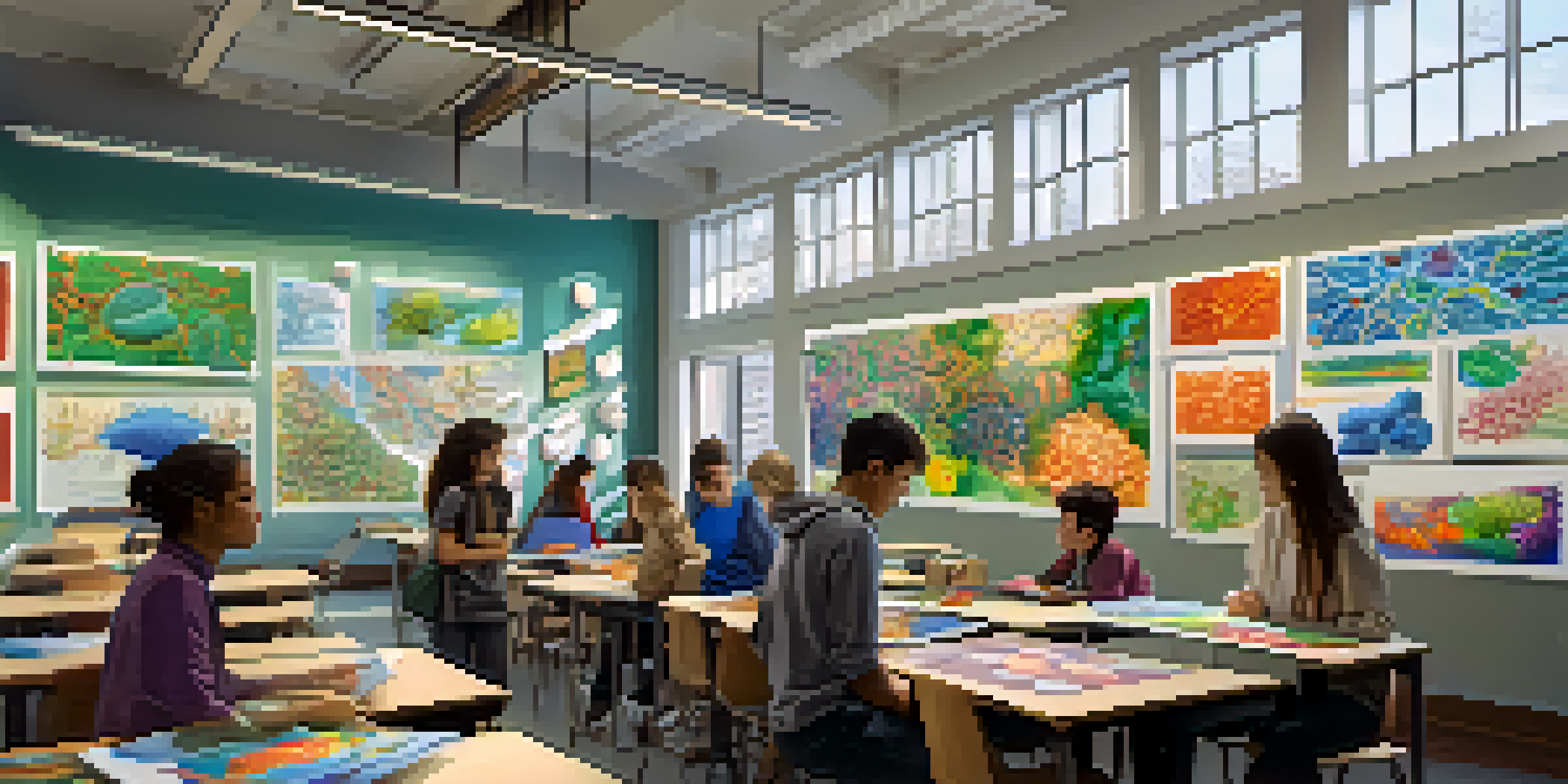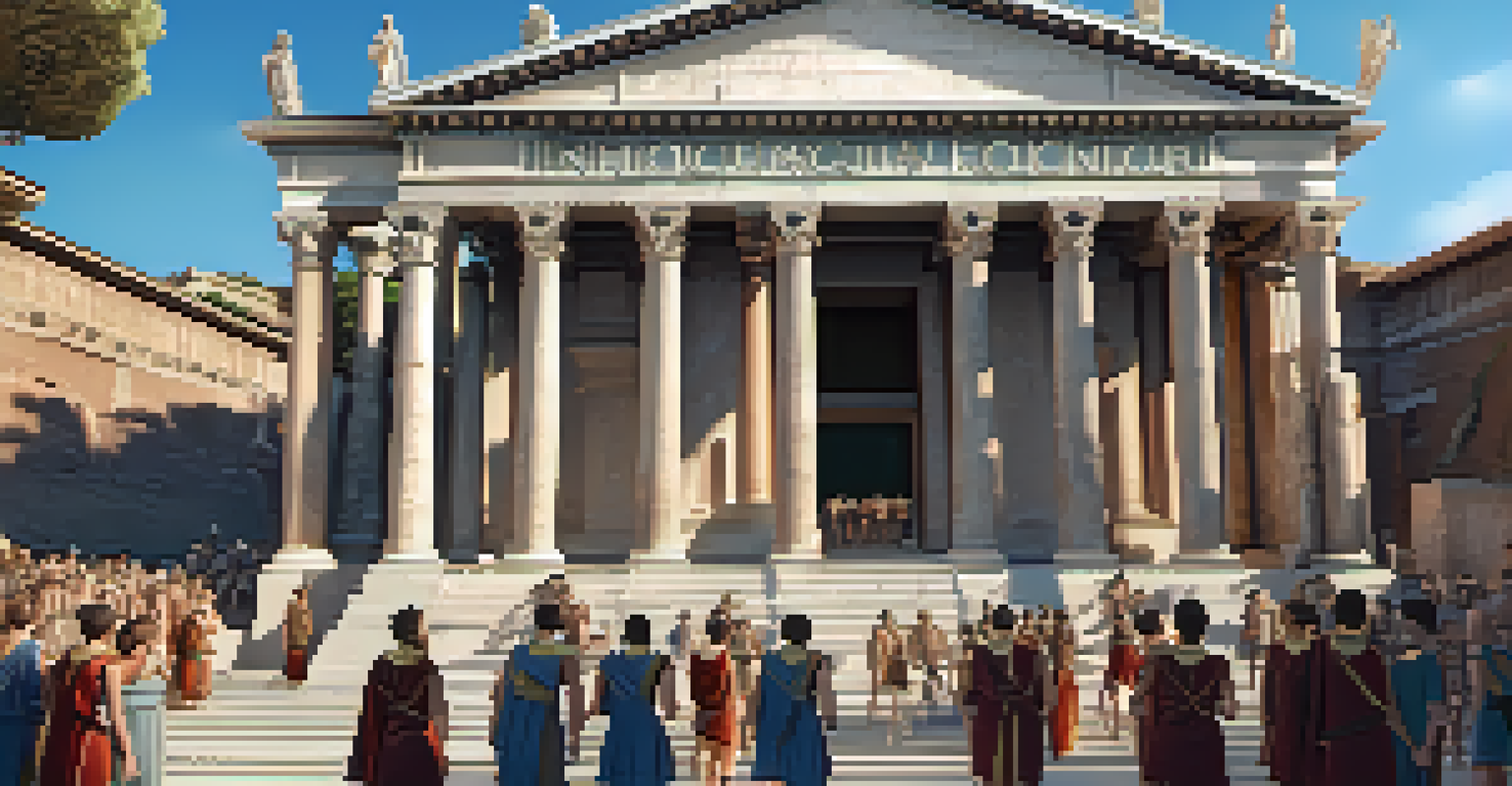AR Simulation: Real-World Applications in Education

Understanding Augmented Reality in Education
Augmented reality (AR) is a technology that overlays digital information onto the real world. Imagine walking through a museum and seeing information about an exhibit pop up on your screen as you point your device at it. This immersive experience captivates students, making learning more engaging and interactive. In education, AR can transform traditional lessons into dynamic experiences that cater to various learning styles.
The great aim of education is not knowledge but action.
For example, during a biology class, students can use AR apps to visualize complex biological processes, such as photosynthesis. Instead of just reading about it in a textbook, they can see the process in action right in front of them. This hands-on approach helps solidify understanding, as students can observe and manipulate the virtual elements to grasp concepts better.
Moreover, AR can bridge gaps in resources, especially in classrooms with limited access to physical materials. By employing AR simulations, educators can provide students with experiences that would otherwise be impossible, like exploring the solar system or diving into the ocean's depths, all from the safety of their classroom.
Enhancing STEM Education with AR Simulations
Science, Technology, Engineering, and Mathematics (STEM) education benefits immensely from AR simulations. These subjects often involve complex theories and formulas that can be challenging for students to visualize. AR allows learners to interact with 3D models and simulations, making abstract concepts more tangible. Picture a physics class where students can manipulate virtual forces and see the real-time effects on objects.

One exciting application is in engineering education, where students can design and test prototypes using AR. They can visualize their designs in a real-world context, assessing functionality and aesthetics before even touching a physical model. This not only enhances creativity but also fosters a deeper understanding of engineering principles.
AR Enhances Interactive Learning
Augmented reality transforms traditional lessons into engaging experiences, catering to various learning styles.
Additionally, AR can facilitate collaborative projects, where students work together to solve problems. By sharing AR experiences, learners can brainstorm and innovate collectively, building teamwork skills that are vital for their future careers.
AR in Language Learning: Breaking Down Barriers
Language learning can be challenging, especially when it comes to vocabulary and grammar. AR provides immersive environments where students can practice language skills in context. Imagine a scenario where learners walk through a virtual market, interacting with vendors and practicing conversational skills in real-time. This practical application boosts confidence and helps solidify language acquisition.
Technology is best when it brings people together.
Moreover, AR can cater to diverse linguistic backgrounds, allowing students to engage with content at their own pace. For instance, an app could translate text or provide audio support in multiple languages, ensuring that all learners feel included. This adaptability makes language learning more accessible and enjoyable.
In addition, gamified AR experiences can motivate students to participate actively in their learning journey. By incorporating elements of play, students are more likely to practice regularly, enhancing retention and fluency over time.
AR in History and Cultural Education
History can often feel distant and abstract to students, but AR brings the past to life. With AR simulations, learners can explore historical events and cultural artifacts in a vivid, interactive manner. For example, imagine walking through a virtual reconstruction of ancient Rome, where students can see and hear what life was like during that time.
This immersive experience fosters a deeper connection to historical content, making it more relatable and engaging. Students can witness significant events unfold or interact with virtual figures, gaining insights into different perspectives and cultures. Such experiences encourage critical thinking as students analyze and discuss the implications of historical events.
AR Supports Diverse Education Needs
AR provides tailored learning experiences that accommodate students with different abilities and backgrounds.
Additionally, AR can facilitate virtual field trips to museums and historical sites, providing access to resources that may be physically out of reach. This democratization of education ensures that all students have the opportunity to explore and learn about our diverse world.
Training and Skill Development Through AR
AR simulations are not just limited to academic learning; they also play a vital role in vocational training and skill development. For instance, medical students can practice surgeries in a risk-free environment, gaining hands-on experience before working with real patients. This practical approach builds confidence and enhances learning outcomes.
Similarly, trades like carpentry or plumbing can be taught using AR tools that guide students through processes step-by-step. As they follow along with virtual instructions, learners can experiment and make mistakes without fear of real-world consequences. This form of practice is invaluable in mastering complex skills.
Moreover, AR can help in assessing student progress. Instructors can track how students interact with simulations, identifying strengths and areas that need improvement. This data-driven approach leads to personalized learning experiences, ensuring that each student receives the support they need to succeed.
AR in Special Education: Tailored Learning Experiences
Augmented reality has significant potential in special education, offering tailored learning experiences for students with diverse needs. For instance, AR applications can provide visual and auditory cues to help students with autism process information more effectively. This multisensory approach creates a more engaging and supportive learning environment.
Additionally, AR can simplify complex concepts, making them more digestible for students with learning disabilities. By breaking down information into manageable chunks and presenting it in interactive formats, educators can foster comprehension and retention. Imagine a student using AR to learn math concepts through interactive visuals instead of traditional worksheets.
Future of AR in Education is Bright
Advancements in AR technology promise personalized and immersive learning experiences for future generations.
Furthermore, AR can promote social interaction among students, helping them develop crucial communication skills. By engaging with peers in AR activities, learners can practice social cues and teamwork in a safe, controlled environment.
The Future of AR in Education: What Lies Ahead?
As technology continues to advance, the future of AR in education looks promising. We can expect even more sophisticated AR applications that will further enhance interactive learning experiences. With developments in artificial intelligence and machine learning, AR tools will become increasingly personalized, adapting to individual learning styles and paces.
Moreover, the integration of AR with virtual reality (VR) could revolutionize education even further, creating fully immersive environments for learners. Picture a classroom where students can explore the depths of the ocean or travel to outer space without leaving their seats. This blend of realities offers limitless possibilities for engaging and impactful learning.

However, it's essential to ensure equitable access to these technologies. As AR becomes more prevalent, educators must focus on providing resources and training to all students and teachers alike. By fostering an inclusive approach, we can maximize the benefits of AR in education, enriching the learning experiences of future generations.